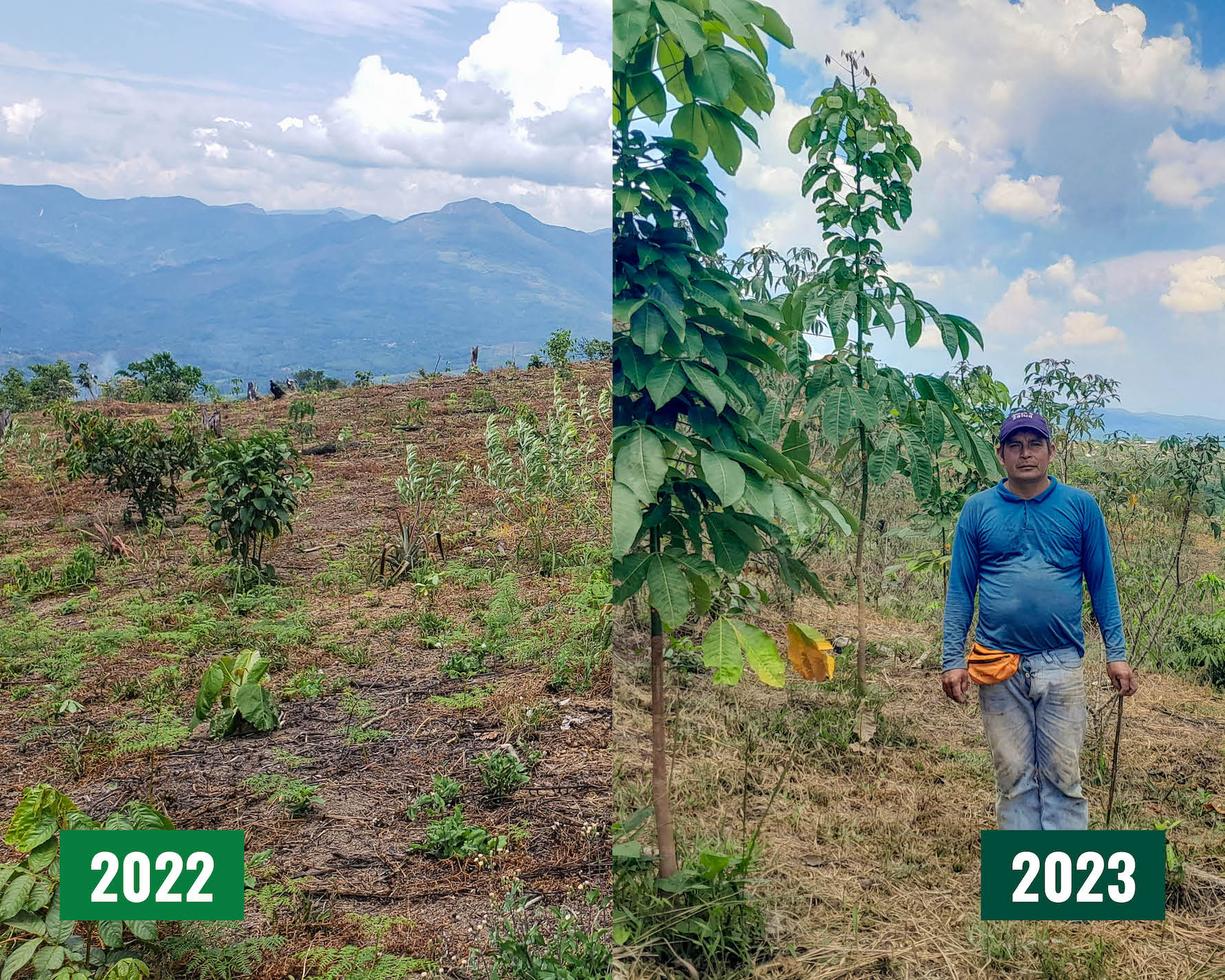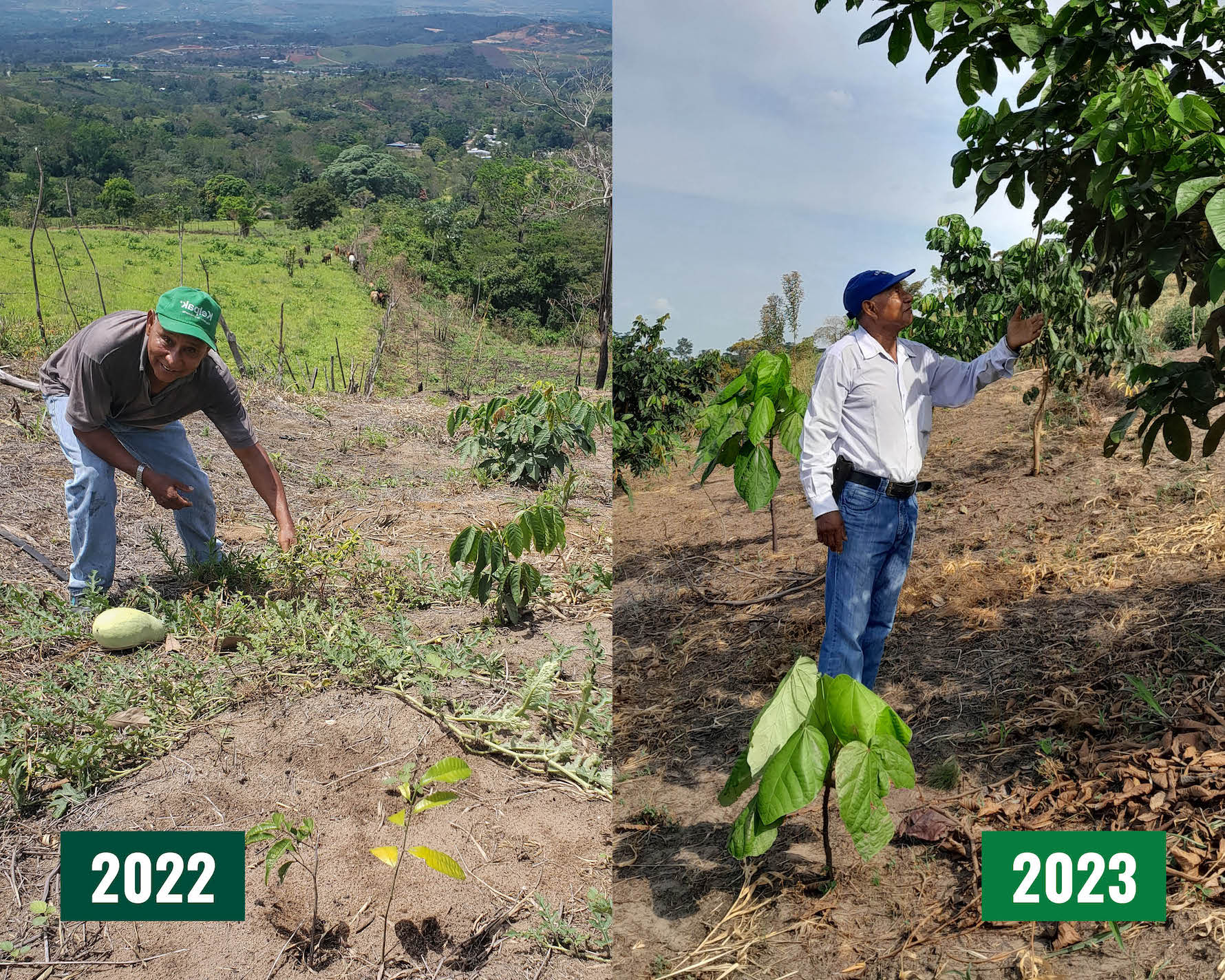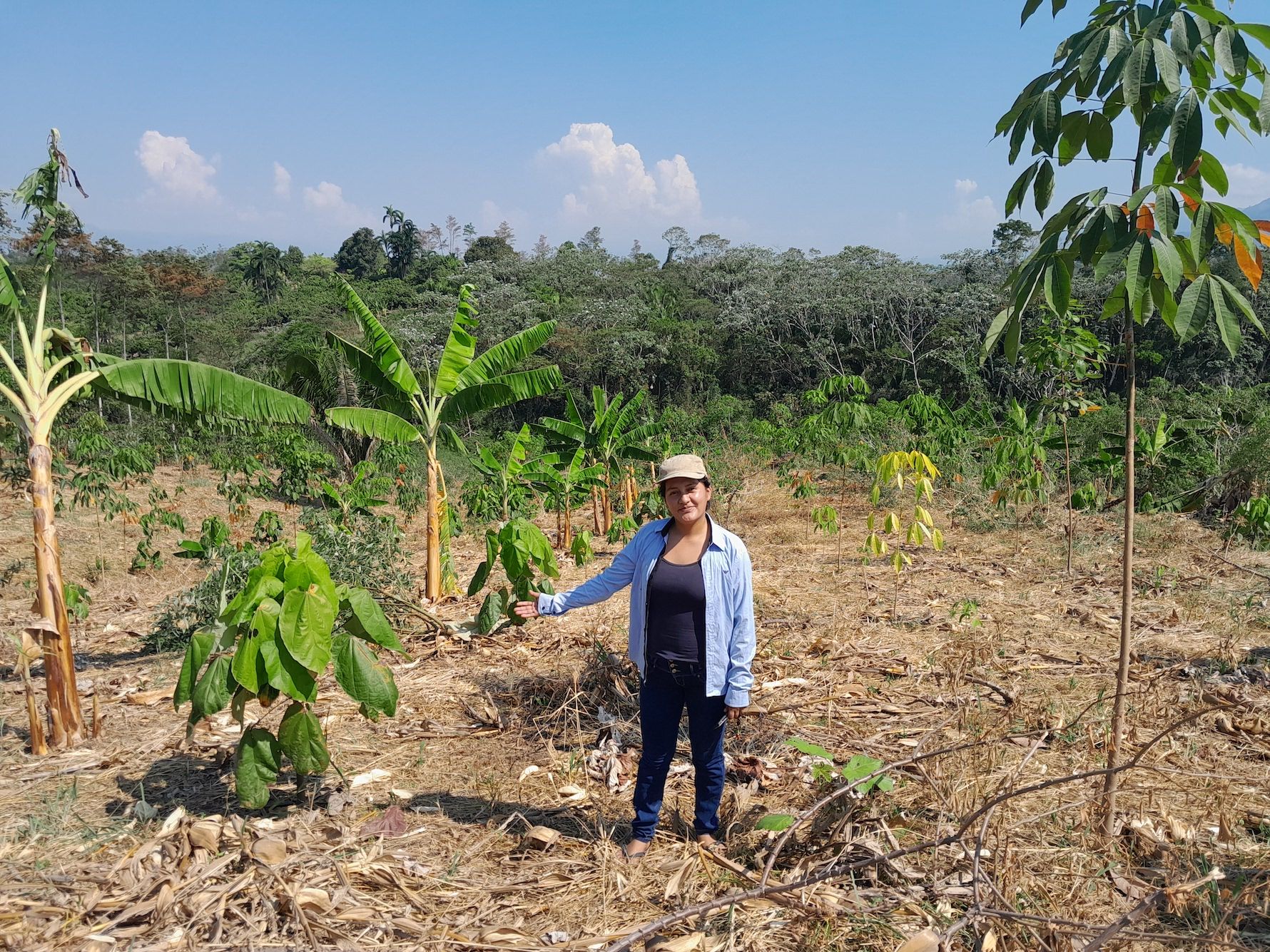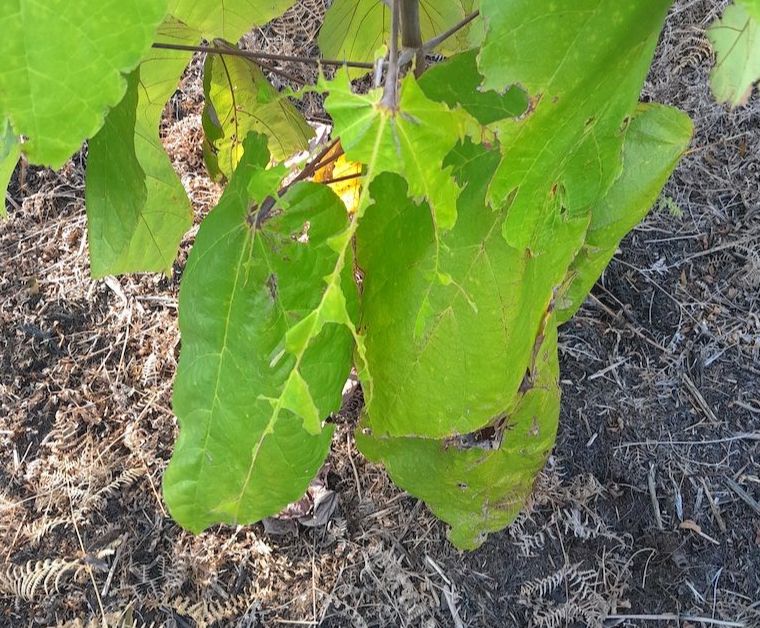In the Peruvian provinces of Lamas, El Dorado, and San Martín, Reforest'Action works in partnership with the CIGDES to support local farmers in setting up agroforestry systems on former abandoned grasslands. The second season of this three-year project came to an end in 2023. A year of intense work saw the planting of 600,000 trees of diverse native species for the maximum benefit of producers who are gradually reclaiming their now fertile land, where they are planting fruit and vegetables in agroforestry. However, faced with increasing drought and the threat of devastating ants, our partner had to redouble its efforts to ensure the survival of the trees. In addition to the future harvesting of tree products, alternative economic activities, such as community beekeeping, are being organized on the ground with the aim of increasing the livelihoods of communities.
The project supported by Reforest'Action and carried out in the field by the Innovation and Management Center for Sustainable Development (CIGDES) is located in three provinces of the San Martín region, at the gateway to the Peruvian Amazon: Lamas, El Dorado, and San Martín. Starting in summer 2021, the project has been running for over two years in an effort to restore vast areas of degraded pasturelands. The objective is to support and accompany landowners in the rehabilitation of their fallow land through the creation of diversified agroforestry systems. Local communities, for whom agriculture is one of the main means of subsistence, have been clearing the Amazon rainforest in recent decades in order to grow food crops and graze livestock. As a result of traditional farming practices, the land has gradually lost its original fertility until it was abandoned by farming and livestock-raising families. These former meadows have been overgrown with spontaneous vegetation and are now covered by several species of invasive ferns, which are particularly prone to fire in the summer. These phenomena prevent the natural regeneration of the forest. The project therefore aims to restore these abandoned lands by planting six to eight tree species (depending on the season) that will both encourage the future regeneration of the native rainforest and create productive, sustainable agroforestry systems for the benefit of local populations.
On the occasion of an audit carried out in August 2023, Juliet, Project Officer in Peru for Reforest'Action, was able to observe the first positive impacts of the project. Beneficiaries from the Kichwa ethnic group, involved in the first planting season, are now convinced of the need for restoration activities: their plots have been cleared of invasive ferns, the trees planted two years ago have grown well, and the return of biodiversity is already noticeable (birds, bees, insects, and macrofauna). Their enthusiasm has attracted other producers keen to support the regeneration of their land, so our partner no longer needs to promote the project among the communities, which are already motivated by the many economic and environmental benefits enjoyed by their neighbors.


The second restoration season: involving local producer families in forestry activities
Work carried out together with communities
During the 2022-2023 project season, 600,000 trees were planted - including Brazilian rubber, breadnut and mocambo tree, and even sweet pea - on over 300 hectares of degraded areas. Beneficiaries, representing 144 farming families newly enrolled in the project, were involved in the forestry work and took part in at least one of 36 training sessions covering planting techniques, plot maintenance, pest management, and more.
Beyond planting, the ecological restoration process involves a range of varied, complex, and physical silvicultural tasks. The first step, among the most important, is to prepare the soil to receive the trees. This means removing all invasive ferns to minimize the impact of the ecological barrier they represent and to guarantee the growth and productivity of the future forest. This work is carried out by each producer on his own plots, assisted by two members of the CIGDES technical team. In the San Martín region, traditional farming organization is reflected in a variety of ways, most notably through the existence of mutual assistance days, known as "choba-choba" in the Kichwa language, and organized by the communal committee. These moments of solidarity are mainly intended to strengthen the harmony between people and natural cycles. The whole family takes part in these events, with everyone contributing according to their abilities and skills. Last season's "choba-choba" enabled landowners to benefit from collective help in completing the preparation of their land. A few days after the weeding was completed, a particular tree species, whose primary function is to prepare the soil, was planted: the pigeon pea, or Cajanus Cajan, of the fabaceae family. The aim of planting this species first is to provide shade on the plot, limit the growth of ferns and other weeds, and enrich the soil with plant biomass to create a microclimate conducive to the growth of young seedlings.

The second step is to install the multi-stage agroforestry system on the producers' plots. The task involves marking out the spatial distribution of plant units to know where to plant fruit and leguminous trees, with a view to creating the pre-established design. This activity is carried out by the CIGDES installation team with the participation of the families, who are at the same time trained in the technical operations of the conception process: taking measurements, using a contour line, aligning, orienting, picketing, and so on. Once the land is ready, the seedlings are transported from the nearest nursery to the area to be reforested, and planting work can begin. A notable improvement in the organization of this second season is the installation of 57 "flying nurseries" on beneficiaries' land, using locally sourced materials. The decentralization of seedling production means that seedlings can be delivered on time with fewer physical constraints. The location of the "flying nurseries" has been decided by the community, which takes responsibility for their maintenance and also acquires precious knowledge about the production of native Amazonian tree species.

Finally, the maintenance of the planted trees is an ongoing task that begins on the last day of planting. The CIGDES has a team of professionals dedicated to monitoring the survival of the planted trees and the success of the restoration process. Their mission is to support producers in their monitoring tasks and to train them through regular workshops on shade management, green manuring, pruning, fertilization, pest, and disease control, etc. In collaboration with Reforest'Action, the CIGDES also benefits from a digital mapping software system that enables them to monitor and trace the planted trees over time.
Search for solutions to climatic and biotic hazards
The survival rate of the trees planted during the project's second season is about 92%. However, this high percentage reflects the continuous monitoring work of our partner, who systematically replants specimens that do not survive. While all the plots are currently in good phytosanitary condition, several challenges were experienced this year, making the restoration of the Amazonian rainforest more difficult.
The summer is getting hotter and hotter in the San Martín region, and the drought is a real challenge. Beneficiaries report how difficult it is to keep the trees alive in this context of climate change. Several measures have been put in place to mitigate the scarce rainfall, including the addition of hydrogel to the soil when the trees are planted to ensure better water retention. In addition, the production of extra seedlings in the CIGDES central nursery effectively overcame drought-related mortality. Another hazard, this time a biotic one, is the presence of devastating ants in the restoration area. To counter this scourge, the participation of some beneficiary producers, who applied biological ant repellents, was key. At the same time, the CIGDES and Reforest'Action decided to collaborate with national and international forestry institutions, such as the Spanish National Institute for Agricultural and Food Research and Technology (INIA) and the Center for International Forestry Research (CIFOR). These partnerships will make it possible to gather scientific knowledge and find effective natural solutions to insect damage.

The socio-economic impact: promoting food security and alternative income generation
Fruits and vegetables grown in agroforestry
Besides its environmental impact, the project includes a significant social component. Expected socio-economic benefits include improved food security for producer families. The agroforestry systems created as part of the project are made up of various productive species, including fruit trees, beans, and peas. These food products will be harvested by the landowners and used for personal consumption or sold. Another benefit of restoring the land by integrating trees is that it makes the soil cultivable and fertile again. Some farming families have already started growing fruit and vegetables (bananas, beans, manioc, etc.), which are the basis of their diet, in the shade of the trees planted in 2021.

Creation of alternative value chains
In the long term, some tree products will help to revive a local, sustainable economy. Indeed, the species planted in agroforestry will provide high-value raw materials, such as latex produced from rubber tree bark, Mayan walnut seeds, and majambo pods, which contain white, almond-flavored beans. Another economic activity that our partner is about to initiate is beekeeping. Several tree species can already produce flowers, and the honey produced can easily be sold on local markets. Awareness-raising sessions on the use of natural inputs will be organized among producers to ensure the survival of the bees. While it is still too early to witness the results, the creation of these alternative value chains will have many positive impacts, including local job creation.

Community capacity building
As the communities are at the very heart of the project's implementation and success, their empowerment represents a major focus. Throughout the year, operational workshops were organized by our partner, not only to train participants but also to gather their expectations and feedback. Since the start of activities, communities have been grouped into 20 community co-management committees in the three provinces where the project is being implemented. This structure ensures the smooth running of operations, as well as the organization of regular assemblies and "choba-choba" days and the monitoring of plantings. This participatory approach also promotes the consolidation and sustainability of ecological restoration.